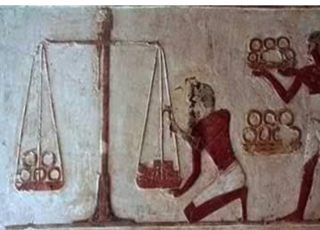Weights in ancient Egypt

Measuring weight in ancient Egypt, represented by the “scale,” which is considered one of the oldest methods invented by man.
It played an important role in organizing and ensuring a stable economic life for the peoples of ancient Egyptian civilization throughout the ages. The scales came as an inevitable result of the necessary response imposed by the economic reality during commodity exchange operations and developed throughout the historical periods that ancient Egypt passed from the pre-dynastic era to the era of the New Kingdom and then the Ptolemaic and Roman periods.
This is evident through its types (basal scale and manual scale) and its various parts that were found in various archaeological sites and are currently preserved in museums.
The ancient Egyptian unit of weight was (diben), which was equivalent to 91 grams
1/12 deben = 7.58 grams (Chianti)
1/10 DBN = 9.1 grams (QD)
DBN = 91 grams (DBN)
This article shed light on the method of measuring weight in ancient Egypt, represented by the “scale,” which is considered one of the oldest methods invented by man, and it played an important role in organizing and ensuring a stable economic life for the peoples of ancient Egyptian civilization throughout the ages. The scales came as an inevitable result of the necessary response imposed by the economic reality during commodity exchange operations and developed throughout the historical periods that ancient Egypt passed from the pre-dynastic era to the era of the New Kingdom and then the Ptolemaic and Roman periods. This is evident through its types (basal scale and manual scale) and its various parts that were found in various archaeological sites and are currently preserved in Egyptian museums.
Source: websites

